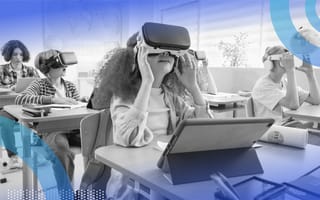Tech has been part of education for a long time, particularly during the pandemic, when lots of instruction went remote. Questions, though, still arise about whether tech-enhanced learning promotes or stymies the ability to think and relate to others in the workforce.
4 Benefits of Tech in Education
- It supports students with diverse needs.
- Tools like virtual reality help students learn faster.
- Tech can build efficient individualized learning programs.
- Tech tools can encourage students to collaborate.
There are definitely those who support technology and those who do not, which leaves educators in particular conflicted on whether to use technology in the classroom.
Tech in the Classroom: Positives and Negatives
On one hand, analog-heavy environments bestow some benefits on students. Students who took notes on laptops performed worse on conceptual questions than students who took notes longhand, according to one series of studies. Another paper showed that using AI in the classroom hampered students’ ability to think critically.
Still, these benefits come with a few asterisks. Gains are most pronounced for gifted students, suggesting that the majority of people perform worse in areas of memory and thinking when they use technology. Studies confirm what we’ve suspected all along — that reduced social skills are linked to increased screen time.
On the other hand, a tech-augmented environment also helps students. For instance, virtual reality-based learning outperforms traditional methods, according to one inquiry. Technology in the classroom has the capacity to better support individualized learning, students with special needs and elicit more active participation from all students.
Technology also boosts student engagement because it shifts the classroom dynamics, allowing students to take more agency and responsibility in their learning. When used properly, technology and internet use helps students explore solutions to real-world problems.
Because there are clear drawbacks and benefits to tech use in classrooms, my view is that the discussion should be about how and when to use technological tools in learning environments, not whether it should be in the classroom at all.
Careers: A Great Use for Tech in the Classroom
Because technology is a helpful tool in our modern society and the demand for tech careers continues to rise, one solution is to align the use of tech with a broader workforce development approach.
In classrooms, educators should lead students in applying tech tools to projects that align with their interests and skills, while being sure to integrate social skills, decision making, emotional intelligence and collaboration.
For example, highly detailed jobs involving numbers are greatly enhanced by technology, but require both reasoning and interpersonal communication for success. Accountants, research analysts, financial analysts, auditors, civil engineers, economists and data scientists use technology to perform their job duties.
However, all these professionals also engage in inferential activities and cannot rely solely on technology to succeed. Each of these jobs require interaction with diverse people as well as collaborative and complex decision-making skills. Children/students with such interests should be given opportunities to engage in diverse approaches to logical/mathematical problem solving, with opportunities to explain their conclusions.
Balancing Digital and Analog Learning Tools
The final question is: what strategies are most effective in balancing the use of tech and analog methods? When using technological methods, educators should frame learning activities in ways that require teamwork and facilitate participation. Under these circumstances, student autonomy, competence, connection to others and engagement increased.
Moreover, educators should help students/children understand the conditions under which technology is most helpful. One example is offering lesson plans where students identify a problem that can be solved with technology.
Another opportunity for blending technology and analog activities is through linking activities to student daily experiences, as well as offering opportunities for students to develop and create their own apps.
In conclusion, the use of technology may be too ingrained in our society to view it through an either-or lens. The greater question may be, “How do we adapt?” Rather than forcing skills from the past onto all students, we may have greater success if we spend more time assessing the specific conditions under which analogy and technology skills are best used.
The next step may likely be investing in more training for integrating technology into classrooms while continuing to innovate curriculum that incorporates technology, hands-on skills, group-based collaboration and project-based learning.





